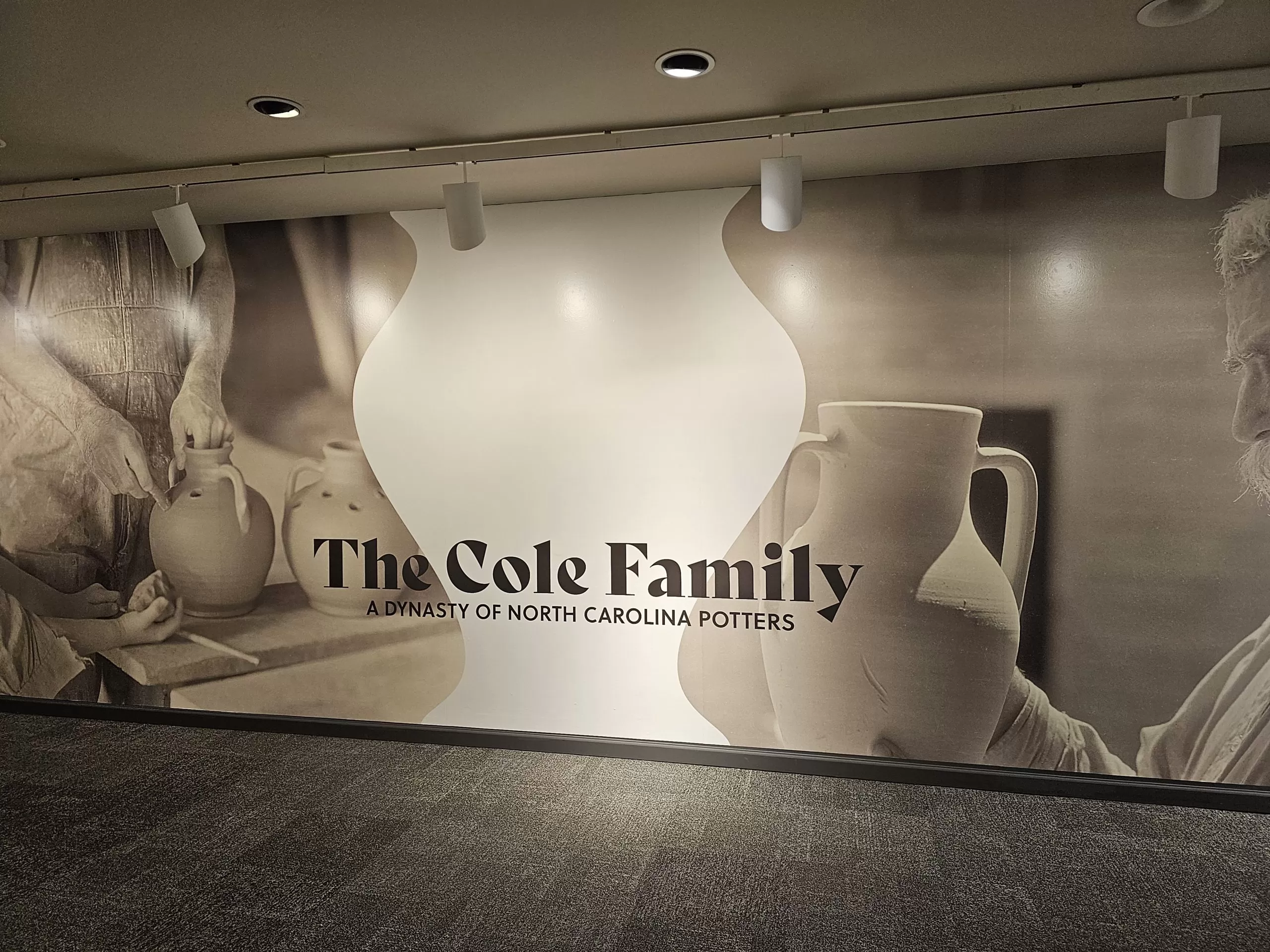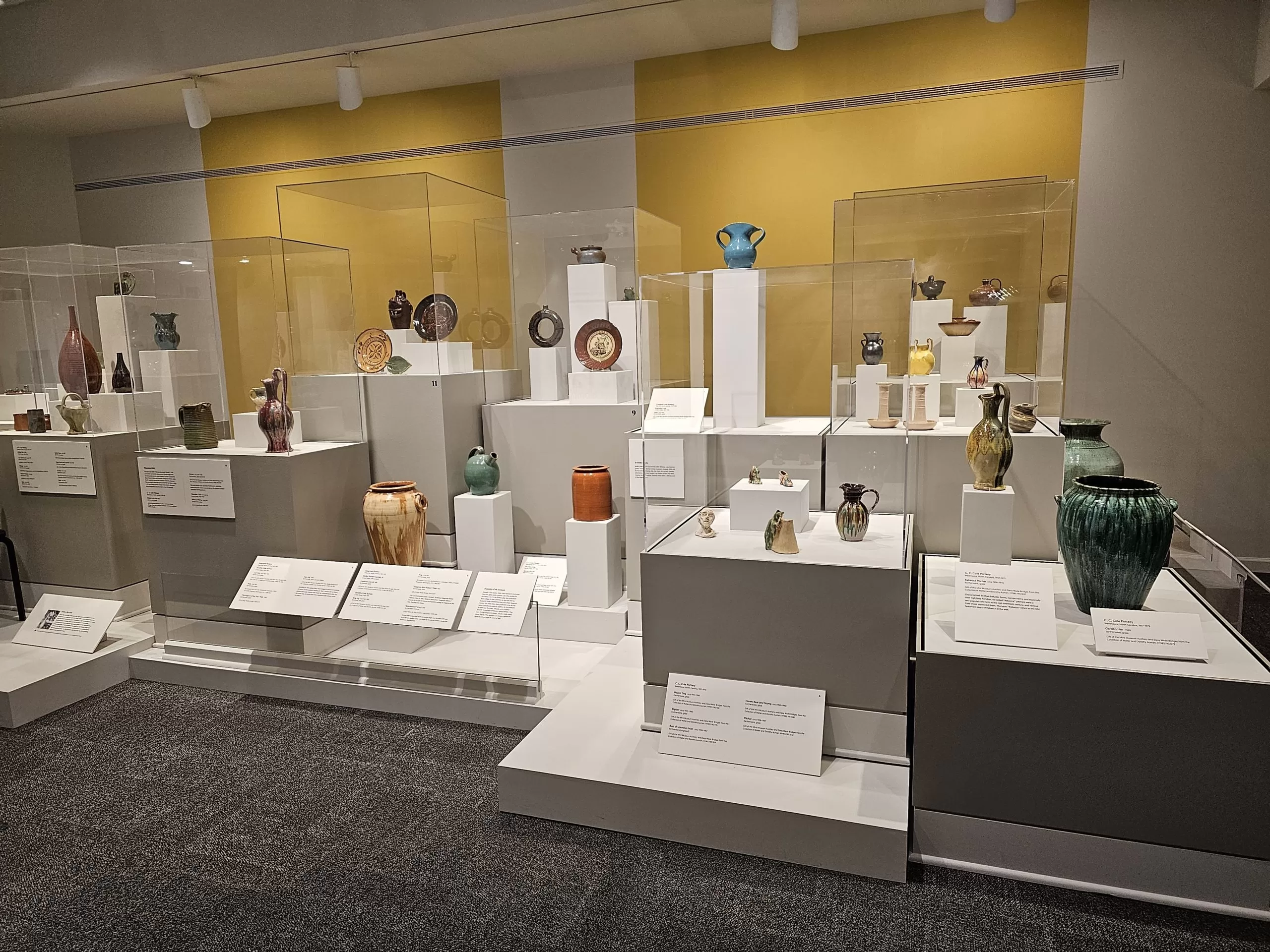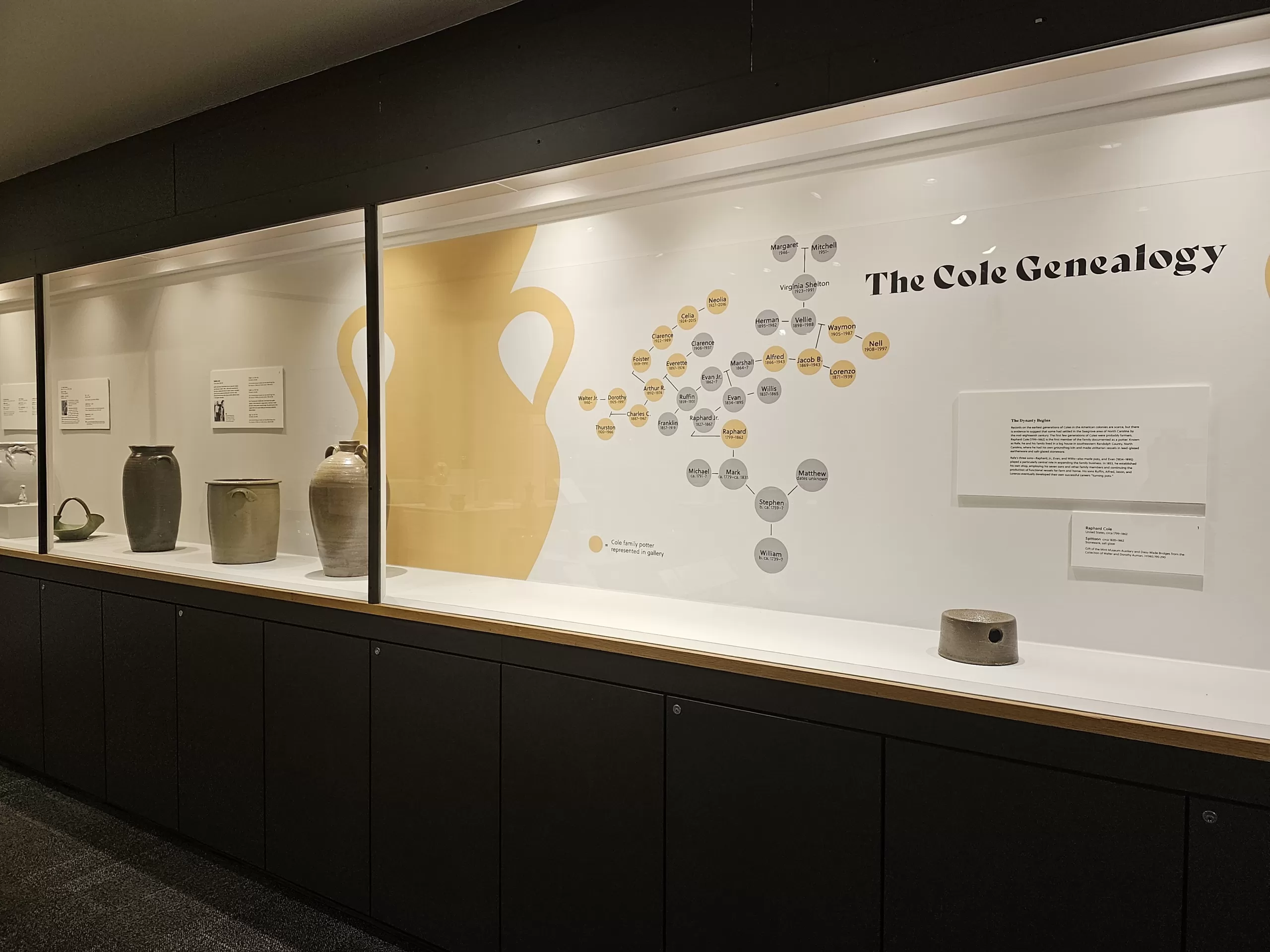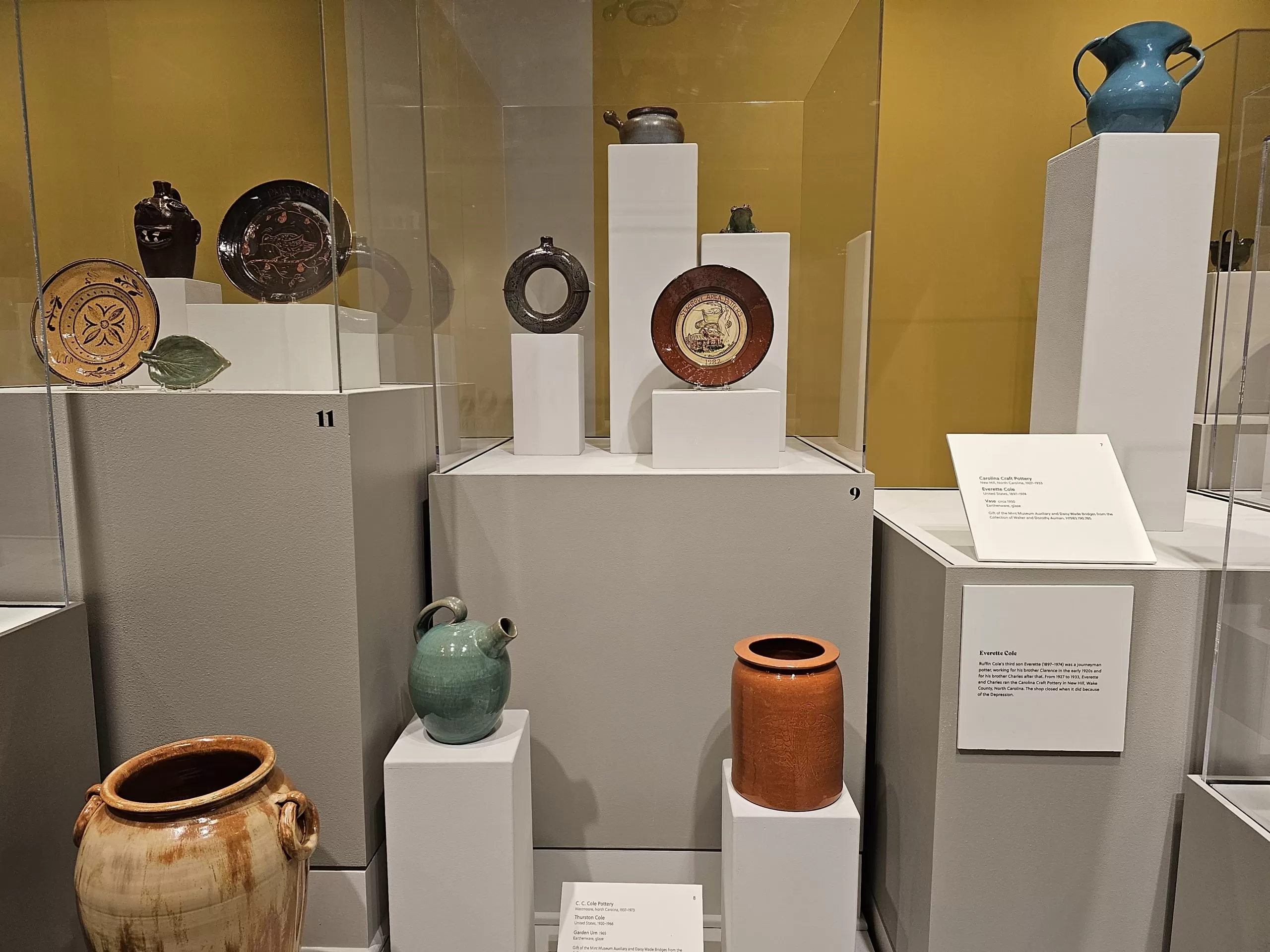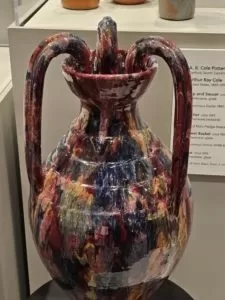Carrying On the Family Name: The Cole Family
by Kate Nixon
The Carolinas have a storied history in local craft including hosting craft schools like the John C. Campbell Folk School, the “pottery paradise” of Seagrove, the oft-exhibited old Edgefield Pottery particularly the works of potter/poet David Drake, the Moravian potters of Forsyth county, and the multi-generational Cole family who created Cole Pottery. When the Mint Museum created an exhibition on the Cole family exploring the works of the stories of each family member as a potter, I jumped at the opportunity to visit the museum on my way to the Charlotte International Airport.
Much like the popular figure of George Ohr was known for utilizing the local organic clay for his works, members of the Cole family harvested local red clay to make jugs and pots – a tradition that has lasted for six generations and currently represented in Charlotte’s own Mint Museum. Originating from central North Carolina – a few counties over from Asheville – the Cole family starting with Raphard Cole (born in 1799), this family helped to create “turning pots” into one of North Carolina’s most enduring traditions. In the 19th century, Raphard and his sons Raphard Jr., Evan and Willis produced stoneware jugs, pots and more as reflected in the needs of that early economy. As times changed, the growing Cole family potters made more creative choices in their works and their offerings grew into pitchers, vases, and other home decorative containers.
Due to the efforts of collectors Walter and Dorothy Cole Auman, a massive collection of works from the Cole family along with stories about each of the Cole family are on display now at the Mint Museum and I, as a new fan, read each story in this new exhibition and remarked on which pots had a passing resemblance to the Arts & Crafts style.
The Cole family tree is shown in the Mint Museum’s exhibition The Cole Family: A Dynasty of North Carolina Potters.
A number of ceramic works from members of the Cole family in the Mint Museum’s special exhibition The Cole Family: A Dynasty of North Carolina Potters.
While there are similar colored glazes to that of Fulper Pottery and one or two forms similar to a few pots I’d seen in the Roseville catalogs, these works had their own qualities that made them different from their Arts & Crafts counterparts. While the earlier members of the Cole family dynasty were just getting started in establishing the Cole family name during the height of the Arts & Crafts movement, the great majority of the potters in this exhibition were children during this time period.
But by no means was I disappointed in the stories. The stories told within the Cole Family exhibition were those of determination, resilience, and passion leading into a true dynasty. Take the story of Charles C. Cole (1887-1967) – the founder of C.C. Cole Pottery and the oldest great-grandson of Raphard – whose pottery skills were acquired at an early age in his father’s shop. Despite the hardship of a Copperhead snake bite to his hand, Charles could not turn on the wheel and yet he managed to lead his own successful pottery from 1937 ownards. His children, Thurston and Dorothy, learned to turn for their father as their uncle Everette did so and continued Charles’s business after his death for another six years. Or Wayman H. Cole (1905-1987), who was small in stature and yet had the strength to knead 60 pounds of clay needed to make a large green urn, a mainstay of gardens and porches.
As you may have surmised, Dorothy Cole Auman, the collector whose curated collection fills this gallery, was a part of this family business, the daughter of Charles C. Cole, and a potter in her own right after learning the craft from her uncle Lorenzo. She and her husband Walter, another potter who came from a family in the pottery business, opened their own shop, Seagrove Pottery named for the area in North Carolina where they settled. Seagrove, N.C. is known for their abundance in potting clay and kiln fuel.
Labelled as an “Assyrian” vase in company catalogs, this three-handled vase from A.R. Cole Pottery was called a “Spider” vase by collectors, due to the resemblance of long spider legs coming from the mouth of the vase.
I was particularly struck by the work of another member of the Cole family: Arthur Ray Cole, the founder of A.R. Cole Pottery. As you can see, this three-handled vase not only has a vibrant and colorful profile in its many glazes, but the form itself is large and in a specific way, a bit frightening. The description for this work says the large vase was listed under the catalog as an “Assyrian” vase, but is called a “Spider” vase by collectors today since its handles look like the legs of a gargantuan spider crawling out of the mouth of the vase. Yikes! Halloween came a little early.
I believe what most struck me about this exhibition is the idea of generations carrying on the family business, an idea that perhaps has suffered a bit in recent years. While the iconic Stickley family had a legacy of their own in furniture, the Cole family continued their family business for SIX generations. Not at all an easy feat. Indeed, the stories told of any potter during the 19th and 20th century is of interest as I continue on my journey to learn the histories of the artisans and business owners of those who not only heralded the movement, but lived the philosophy of utilizing the local elements to create handcrafted beauty.
It should be noted however that my love for the Arts & Crafts style reappeared in the next room as I immediately spotted a Rookwood vase from 100 feet away. My friend who went with me noted that while most museum visitors were attracted to the large crystal vase in the display case across the room, I had made a beeline to the American art pottery case across the way. The case was filled with Rookwood, Teco, Grueby, Weller and the others with whom I was familiar: my eyes were wide open and ready to take in yet another story.
.

